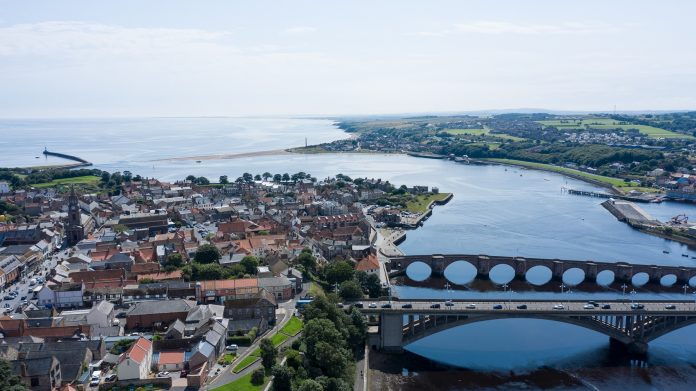On the many occasions I have been to visit Berwick, I have always turned right out of the station to follow Castlegate into the town centre. This time, I turned left over the railway, looking out for the 1937 Coronation Park on the left, through which runs a footpath downhill to the north bank of the River Tweed. I was walking the new three mile Tweed and Coast nature trail, supported by many local bodies and charitable foundations, and devised by the local U3A. There are fourteen information boards on the trail which runs through Berwick and Tweedmouth via the docks to Spittal beach so the path is part riverside, urban, industrial, dunes and seaside promenade. Spittal has a long and wide expanse of sandy beach, and is rather nicer than the name might imply. In the 1800s it was a popular spa. A similar trail about L. S. Lowry, the artist, is available.
There is plenty of wildlife to see and the information boards are attractive and, notably, are changed for each season four times a year to keep the content relevant. A simple idea, but I have not seen it done before in practice. The group organising the trail has just installed the summer versions of the boards. One told of the 2m long Pholiderpeton fossil – might have been useful for helping social distancing.
I passed through the ruins of Berwick Castle at low level and was impressed by the grandeur of the Royal Border Bridge, which was officially opened by Queen Victoria on 29th August 1850 on her way to Balmoral, a process which took only twelve minutes from her train arriving to continuing over the border, 2.5 miles further north. (It was a good day for rail openings: she had opened Newcastle Central station earlier the same day.) I continued into town under the 1928 Royal Tweed Bridge which relieved most of the traffic on the Berwick Old Bridge of 1633, which I crossed to Tweedmouth. Road traffic had to trundle through the town until the opening of the A1 Berwick bypass in 1984.
It’s much quieter now, and although the population is around 12,000 you would think it were bigger owing to the large number of villages in both England and Scotland which look to it as their local centre. I was originally intending to visit after the pubs and restaurants reopened on 4th July, but I reckoned that since Berwick pubs were the closest for locked down Scots up to 300 miles away it might be wiser to visit beforehand. I enjoyed fish and chips at the Cannon near the station and ate them in Castle Vale Park with its view of the rail bridge, but I could have sat out at the open air café in Spittal. On the nature trail you also pass the Berwick Shellfish which had a good range of seafood. They offer to put it in a polystyrene box with ice for just £1 extra to take home.
From Spittal there is a choice of walking back along Main Street and over the river to town, or use the Borders Buses route B1, which runs half-hourly (hourly on Sundays). If you don’t want to visit the town centre, the bus goes back close to the station. I spotted the Spittal War Memorial off Main Street and behind it a fountain which was an iron-rich chalybeate spa, but there was no indication whether the water was safe to drink. So I didn’t.
Alex Nelson travelled to Berwick from Newcastle with CrossCountry for £9.90 and returned with LNER for £8.20.





